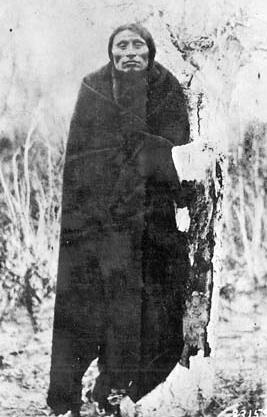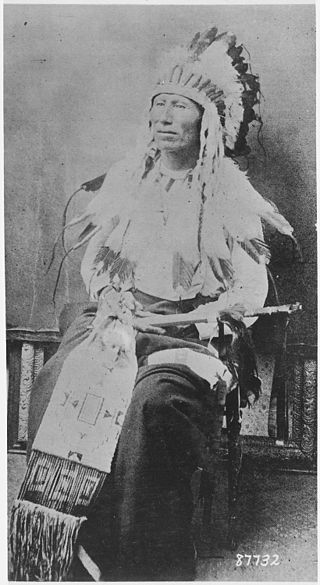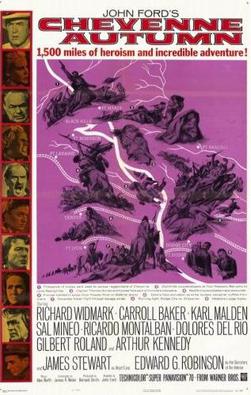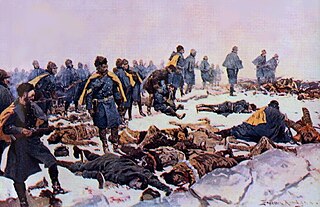
Howard Melvin Fast was an American novelist and television writer. Fast also wrote under the pen names E.V. Cunningham and Walter Ericson.

Little Wolf was a Northern Só'taeo'o Chief and Sweet Medicine Chief of the Northern Cheyenne. He was known as a great military tactician and led a dramatic escape from confinement in Oklahoma back to the Northern Cheyenne homeland in 1878, known as the Northern Cheyenne Exodus.

Morning Star (1810–1883) was a great chief of the Northern Cheyenne people and headchief of the Notameohmésêhese band on the northern Great Plains during the 19th century. He was noted for his active resistance to westward expansion and the United States federal government. It is due to the courage and determination of Morning Star and other leaders that the Northern Cheyenne still possess a homeland in their traditional country in present-day Montana.

He Dog. A member of the Oglala Lakota, He Dog was closely associated with Crazy Horse during the Great Sioux War of 1876-77.
Buffalo Calf Road Woman, or Brave Woman, was a Northern Cheyenne woman who saved her wounded warrior brother, Chief Comes in Sight, in the Battle of the Rosebud in June 1876. Her rescue helped rally the Cheyenne warriors to win the battle. She fought next to her husband in the Battle of the Little Bighorn nine days later. In 2005 Northern Cheyenne storytellers broke more than 100 years of silence about the battle, and they credited Buffalo Calf Road Woman with striking the blow that knocked Lieutenant Colonel George Armstrong Custer off his horse before he died.

DeForest Richards was an American banker, farmer, and politician. He was the fifth Governor of the state of Wyoming, and the first to die while still in office.

Cheyenne Autumn is a 1964 American epic Western film starring Richard Widmark, Carroll Baker, James Stewart, and Edward G. Robinson. It tells the story of a factual event, the Northern Cheyenne Exodus of 1878–79, told in "Hollywood style" using a great deal of artistic license. The film was the last western directed by John Ford, who proclaimed it an elegy for the Native Americans who had been abused by the U.S. government and misrepresented by many of the director's own films. With a budget of more than $4 million, the film was relatively unsuccessful at the box office and failed to earn a profit for its distributor Warner Bros.

Mari Susette Sandoz was a Nebraska novelist, biographer, lecturer, and teacher. She became one of the West's foremost writers, and wrote extensively about pioneer life and the Plains Indians.

The Red Cloud Agency was an Indian agency for the Oglala Lakota as well as the Northern Cheyenne and Arapaho, from 1871 to 1878. It was located at three different sites in Wyoming Territory and Nebraska before being moved to South Dakota. It was then renamed the Pine Ridge Reservation.
The 1953 Cleveland Indians season was a season in American baseball. The team finished second in the American League with a record of 92–62, 8½ games behind the New York Yankees.

Ledger art is a term for narrative drawing or painting on paper or cloth, predominantly practiced by Plains Indian, but also from the Plateau and Great Basin. Ledger art flourished primarily from the 1860s to the 1920s. A revival of ledger art began in the 1960s and 1970s. The term comes from the accounting ledger books that were a common source of paper for Plains Indians during the late 19th century.

The Northern Cheyenne Exodus, also known as Dull Knife's Raid, the Cheyenne War, or the Cheyenne Campaign, was the attempt of the Northern Cheyenne to return to the north, after being placed on the Southern Cheyenne reservation in the Indian Territory, and the United States Army operations to stop them. The period lasted from 1878 to 1879.

The Fort Robinson breakout or Fort Robinson massacre was the attempted escape of Cheyenne captives from the U.S. army during the winter of 1878-1879 at Fort Robinson in northwestern Nebraska. In 1877, the Cheyenne had been forced to relocate from their homelands on the northern Great Plains south to the Darlington Agency on the Southern Cheyenne Reservation in Indian Territory (Oklahoma). In September 1878, in what is called the Northern Cheyenne Exodus, 353 Northern Cheyenne fled north because of poor conditions on the reservation. In Nebraska, the U.S. Army captured 149 of the Cheyenne, including 46 warriors, and escorted them to Fort Robinson.
John Woodenlegs was a Native American writer, educator, and the tribal president of the Northern Cheyenne from 1955 to 1968. In 1975, he founded Chief Dull Knife College, a community college located in Lame Deer, Montana.

The Mari Sandoz High Plains Heritage Center is a museum dedicated to the life and works of author Mari Sandoz, and to the High Plains region of the western United States, in which Sandoz grew up, and which was the setting of many of her fictional and non-fictional works. The Center is located on the campus of Chadron State College in Chadron, Nebraska. It occupies the college's former library building, which is listed in the National Register of Historic Places.

Agents of Repression: The FBI's Secret Wars Against the Black Panther Party and the American Indian Movement is a book by Americans Ward Churchill and Jim Vander Wall, first published in 1988. It describes government campaigns to disrupt the legal political activities of the Black Panther Party and the American Indian Movement, especially through actions of the FBI.
This study gives a chilling account of the government attack against the American Indian Movement and the Black Panther Party, placed in the context of the traditional use of the FBI for domestic political repression. It is a powerful indictment, with far–reaching implications concerning the treatment of political activists, especially those that are Black or Native American, and the functioning of our political institutions generally.
The Mizpah Creek incidents, were a series of incidents that occurred from April 5 – June 8, 1879, between United States soldiers and civilians, and eight Northern Cheyennes, that resulted in the death of one U.S. soldier, and the capture of the eight Cheyenne, three of whom committed suicide in prison at Miles City, Montana Territory. The incidents occurred near Mizpah Creek, a tributary of the Powder River, in Montana Territory.

The Horsecatcher is a 1957 adolescent historical novel by American author Mari Sandoz. The Horsecatcher was a Newbery Medal Honor Book in 1958. The book is "dedicated to the two great Cheyennes named Elk River, both council chiefs and peace men, one Keeper of the Sacred Arrows of the Cheyenne Indians, the other the greatest horsecatcher of all the High Plains".

Joseph Balmer was a noted Swiss 20th century historian and expert on Native Americana.

The Battle of Sappa Creek, or Massacre at Cheyenne Hole, was a battle fought on April 23, 1875, between Company H of the Sixth United States Cavalry under the command of Second Lieutenant Austin Henely and a group of Cheyenne Indians led by Little Bull. The conflict took place in modern-day Rawlins County, Kansas, and was both the final and the deadliest battle in the Red River War.















